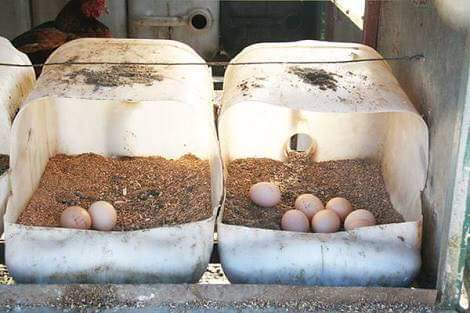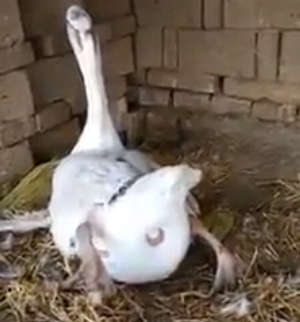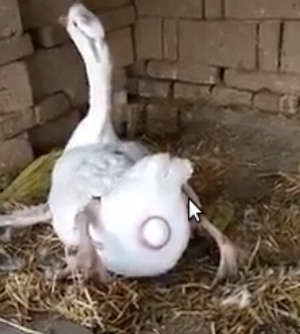What time of day to chickens lay eggs?

A hen will normally lay an egg in the morning although I often get egg up until 2 or 3 in the afternoon. The timing of oviposition, or egg-laying, varies with a chicken's breed and how much light exposure she gets. It is most common for chickens to lay an egg in the morning, or more accurately between 2 and 6 hours after sun up.
When I let mine out at around 7 am there is never normally an egg in the nest unless it is mid summer and it has been light a few hours. There is then a bit of a queue for the nest boxes between 9 and 11 and then things quieten off by the time afternoon arrives.
When do chickens lay eggs?
If a chickens laid an egg at 8 am on Monday, then she would probably lay again around 10 am on Tuesday, midday on Wednesday, 2 on Thursday and then have Friday off before going back to 8 am on Saturday. The average backyard chicken keeper will likely see their egg in the nests between 9 am and 2 pm with the odd straggler here and there.
Below: Every chicken keeper loves a nest full of eggs.

Chickens have a sophisticated biological mechanism that make sure they lay mostly in the morning and never at night
There are triggers that cause a hen to release a yolk to start the egg on its journey through the oviduct or egg tube. That journey is about 25 hours but that can vary a little.
The biggest of those triggers is daylight and day length. The red light in the afternoon sunshine means roosting time is close and that should stop her from starting an egg that has to be laid at night.
A chickens will lay an egg every 25 to 26 hours.
If a yolk was to be released into the oviduct at 9 pm then it would be laid about 10 pm the next day whilst the chicken was roosting which is an undesirable situation. So the chicken evolved a strategy to cope and not waste any eggs.
This does go awry sometimes and I have found the odd egg on the coop floor or droppings board in the morning.
So the time of day a chickens lays it's eggs is as dependant of the time of year as anything else, 6 hours after sun up in the middle of winter is about 3 in the afternoon and nearly roosting time again.
Below: The mornings eggs in the nest.

Chickens are said to lay one egg every 25 to 28 hours, depending on the breed and individual, so it would stand to reason that they would lay about an hour later in the day each day until the skip a day.
My hens tend not to lay eggs before 9 am and are ordinarily done by 3 pm. I've had the odd rare early or late deposit, but this is the exception, not the rule.
Exposure to light:
A chickens reproductive cycle is controlled by a photo-period. This is the length of time she is exposed to daylight above a certain level so is governed by the seasons in nature.
Hens require at least 12 hours of light per day to lay eggs and have a peak production rate for eggs at 16 hours of daylight. They can lay egg with as little as 8 hours of daylight, it is just a great deal fewer eggs, sometimes just 2 or 3 a week. I keep Barnevelders which are renowned for their winter laying ability.
Hens generally lay eggs within six hours of sunrise which is why commercially hens are given at least 16 hours of daylight, even if it is artificial.This fools their systems into thinking it is mid summer all the time and they keep laying at max rate.
Hens without exposure to artificial lighting in the hen house will stop laying eggs in late fall for about two months. They begin laying again as the days begin to lengthen in late winter.
Genetic factors:
The genes of a chicken influence her laying period.
Brown-egg breeds tend to lay earlier in the day. There is another reason for this, brown egg layers as a rule lay far fewer eggs than their lighter egged cousins. They also tend to be better winter layers and more consistent.
White and green / blue egg breeds tend to lay later in the day.
Hybrids are bred to be producers and have been selected so they have a shorter egg cycle and in some cases can lay an egg a day. Every day for an entire year.
Of all my chickens it's the hybrids I've had that laid an egg at the same time every day. It's more normal for them to gradually get later each day but not all are identical, it can vary by hen.
Broiler or meat birds lay fewer eggs than laying hens. Broiler chickens have been the most over-bred and hybridised of all poultry and may lay their eggs any time. This is rarely a problem as they are too heavy to fly up to roost.
Why do hens lay eggs at night?
Hens are not supposed to lay eggs at night but it does happen from time to time.
Most pullets do get it right from the start and begin to lay eggs with no trouble at all but the hen’s internal egg making system is fairly complicated.
It’s not that unusual for a pullet to have a hiccup in her system. One of those kinks might be when she starts an egg. If a yolk is released at the wrong time the egg may appear while the bird is roosting in the middle of the night. This is when you see one on the floor or the droppings board in the morning. Chickens often roost in the same spot every night so you might be able to work out who the overnight egg layer is.
When birds start laying it's not unusual to see thin-shelled or no-shelled eggs, eggs with extremely thick shells, Two or more shells, double, triple or more yolkers, no yolkers, no whites, or just plain weird eggs.
What’s remarkable to me is that so many actually get it right to start with.
Diet deficiencies, disease and frights may also cause hens to lay eggs at night as it disrupts their cycle.
How an egg is laid:
In the hen the ovary lies in the centre of the cavity of the body, and is attached to the back bone, and closely resembles a bunch of grapes. The small yellow yolks or ovules vary in size from that of a pin head to that of a walnut, and each is attached to the ovary by a stem or string. There are many of them in several stages of development.
The hen's egg is a mass of cells and tissue of different kinds, encased in a shell and protective bloom. The yolk is released from what is called the egg mass an drops into the funnel shaped opening at the top of the oviduct.
Below is three images of a goose laying an egg but the process is the same in chickens.
The egg appears in the cloaca.

The egg is produces blunt end first.

The egg is laid.

The egg travels slowly down a long tube called the oviduct where the egg white, membranes and eggshell form around the yolk. The oviduct is a muscular tube with a similar way of moving the contents as the intestines do, by regular muscular contraction.
The shell is added right at the end of the process just before the egg is laid and if you are careful it can often be felt in between the chickens legs as a hard lump.
She lays the egg by pushing it out her cloaca, the single opening for her reproductive, urinary and intestinal tracts. It takes about 25 hours from start (ovulation) to finish (oviposition).
When hens are in heavy lay, there are often two eggs in the oviduct, one is just entering while the other is receiving its shell. It is also quite possible for a chicken to lay two perfectly normal eggs in one day especially in the later days of spring with ample food and long days.
How hens control egg timings:
A laying hen produces on average one egg every 25 hours. Around 25 hours means it might 24 or it might be 28 but if you average it out you'll get around 25 if you have a lot of hens.
A hen controls what time she lays by not ovulating and producing a yolk at night. Then she won't lay eggs in the dark. Hens usually ovulate in the morning but can ovulate as late as 3 pm. Ovulation occurs about an hour after laying an egg.
If a hen lays an egg in the afternoon, she may delay ovulating again until the following day. That egg will be laid about 26 hours later. This is why hens regularly skip a day of egg-laying.
Actual egg production rates vary with day length, seasons, feed availability and health. All these factors influence the time of day an egg is laid, so it varies with each egg. But it usually occurs in the morning or early afternoon.
Most hens lay in the morning for different reasons. It normally takes somewhere around 25 hours for an egg to go through the hen's internal egg making factory from the time the yolk is released to start the journey until the egg is in the nest.
There are different triggers that tell a hen when to release the yolk to start the egg on it's internal journey.
Contrary to what you might think laying an egg is not a trigger to start another one. It is quite possible for the hen to have two eggs in the oviduct at the same time, one at the top and the other ready to be laid.
To avoid them needing to lay an egg after dark, daylight can trigger them to start that yolk or delay for a day.
Not every hen lays every day either, so the triggers probably key into starting the egg so it will be laid in the morning instead of gradually getting later.
Should you keep your hens locked up in the morning?
I don't keep my hens locked up until they lay. They generally know to return to the coop when it is time to produce an egg.
Not every hen does though and some love to hide eggs in all sorts of strange places.
When you find a hen not laying in your coop or nest boxes, a good way to retrain them is to leave them locked in the coop and run until they lay the egg or just leave them locked up. Usually a week is enough but not always and it can get frustrating for a free range bird to be confined.
It helps if you can find that hidden nest and remove the eggs. Locking them up does not guarantee they will use the nests but at least it is in the coop. Alternatively just let them use the wild nest and collect the eggs from it as normal.
As long as they are roosting in the coop as normal and you have open and accessible nesting boxes ready well before they start to lay I would not worry. Put a fake egg in each nest to show them it's a good place to lay. You can use golf balls, fake or ceramic eggs or even smooth stones from a river bed.
If you have an older hen who lays in nest boxes use her as a teacher. This is a fantastic method as young birds will often copy older ones. I use this method to teach incubator raised chicks how to roost and it works wonders. Then see where they lay when they start.
As long as you have plenty of room and good ventilation you don't have to be in that big of a hurry to let them out in the morning, delaying some letting them out could help, but usually you don't have to do that.
I consider leaving them locked up more of a way to correct a problem as opposed to a preventative measure, but it can help prevent a problem.
